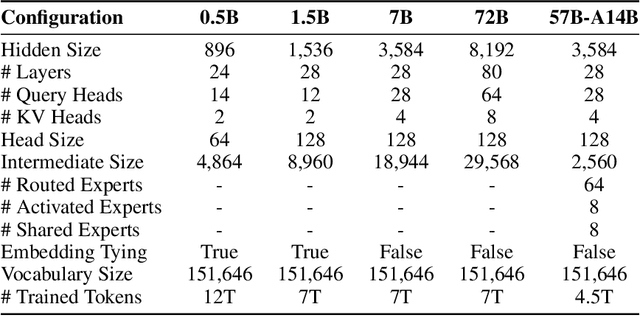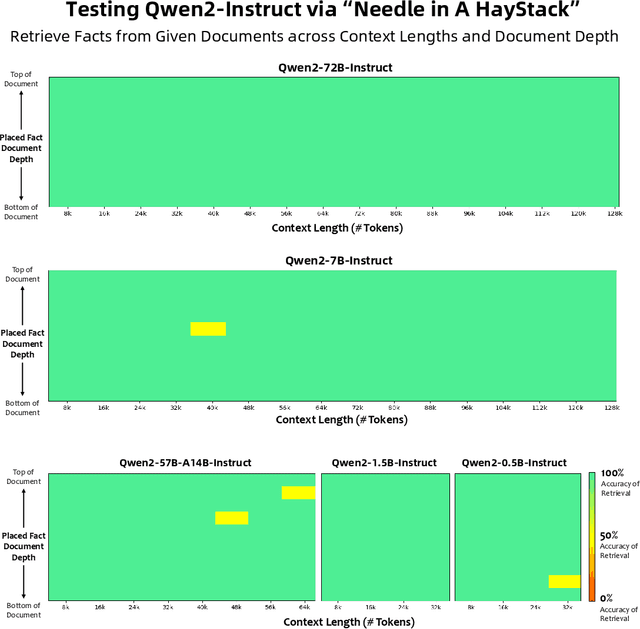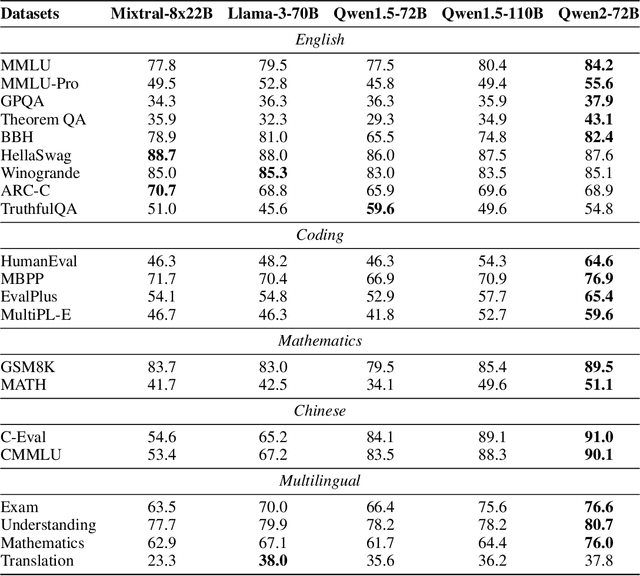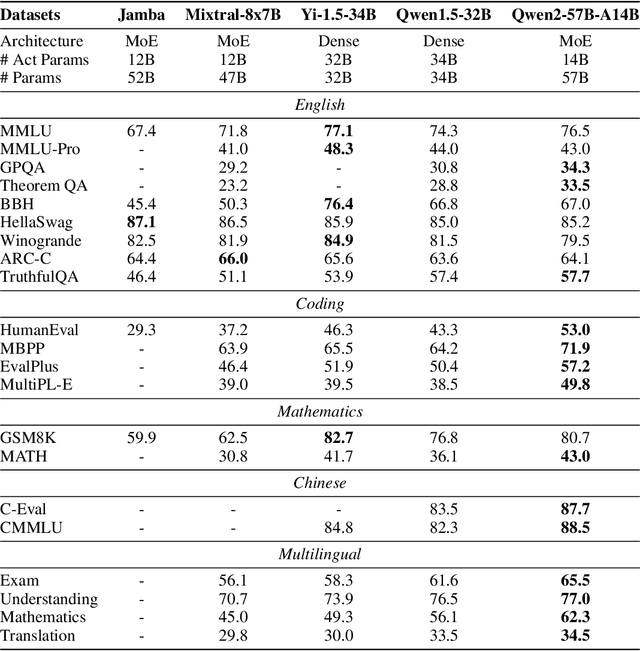Chang Zhou
Crab: A Unified Audio-Visual Scene Understanding Model with Explicit Cooperation
Mar 17, 2025Abstract:In recent years, numerous tasks have been proposed to encourage model to develop specified capability in understanding audio-visual scene, primarily categorized into temporal localization, spatial localization, spatio-temporal reasoning, and pixel-level understanding. Instead, human possesses a unified understanding ability for diversified tasks. Therefore, designing an audio-visual model with general capability to unify these tasks is of great value. However, simply joint training for all tasks can lead to interference due to the heterogeneity of audiovisual data and complex relationship among tasks. We argue that this problem can be solved through explicit cooperation among tasks. To achieve this goal, we propose a unified learning method which achieves explicit inter-task cooperation from both the perspectives of data and model thoroughly. Specifically, considering the labels of existing datasets are simple words, we carefully refine these datasets and construct an Audio-Visual Unified Instruction-tuning dataset with Explicit reasoning process (AV-UIE), which clarifies the cooperative relationship among tasks. Subsequently, to facilitate concrete cooperation in learning stage, an interaction-aware LoRA structure with multiple LoRA heads is designed to learn different aspects of audiovisual data interaction. By unifying the explicit cooperation across the data and model aspect, our method not only surpasses existing unified audio-visual model on multiple tasks, but also outperforms most specialized models for certain tasks. Furthermore, we also visualize the process of explicit cooperation and surprisingly find that each LoRA head has certain audio-visual understanding ability. Code and dataset: https://github.com/GeWu-Lab/Crab
GCoT: Chain-of-Thought Prompt Learning for Graphs
Feb 12, 2025Abstract:Chain-of-thought (CoT) prompting has achieved remarkable success in natural language processing (NLP). However, its vast potential remains largely unexplored for graphs. This raises an interesting question: How can we design CoT prompting for graphs to guide graph models to learn step by step? On one hand, unlike natural languages, graphs are non-linear and characterized by complex topological structures. On the other hand, many graphs lack textual data, making it difficult to formulate language-based CoT prompting. In this work, we propose the first CoT prompt learning framework for text-free graphs, GCoT. Specifically, we decompose the adaptation process for each downstream task into a series of inference steps, with each step consisting of prompt-based inference, ``thought'' generation, and thought-conditioned prompt learning. While the steps mimic CoT prompting in NLP, the exact mechanism differs significantly. Specifically, at each step, an input graph, along with a prompt, is first fed into a pre-trained graph encoder for prompt-based inference. We then aggregate the hidden layers of the encoder to construct a ``thought'', which captures the working state of each node in the current step. Conditioned on this thought, we learn a prompt specific to each node based on the current state. These prompts are fed into the next inference step, repeating the cycle. To evaluate and analyze the effectiveness of GCoT, we conduct comprehensive experiments on eight public datasets, which demonstrate the advantage of our approach.
SAMGPT: Text-free Graph Foundation Model for Multi-domain Pre-training and Cross-domain Adaptation
Feb 08, 2025Abstract:Graphs are able to model interconnected entities in many online services, supporting a wide range of applications on the Web. This raises an important question: How can we train a graph foundational model on multiple source domains and adapt to an unseen target domain? A major obstacle is that graphs from different domains often exhibit divergent characteristics. Some studies leverage large language models to align multiple domains based on textual descriptions associated with the graphs, limiting their applicability to text-attributed graphs. For text-free graphs, a few recent works attempt to align different feature distributions across domains, while generally neglecting structural differences. In this work, we propose a novel Structure Alignment framework for text-free Multi-domain Graph Pre-Training and cross-domain adaptation (SAMGPT). It is designed to learn multi-domain knowledge from graphs originating in multiple source domains, which can then be adapted to address applications in an unseen target domain. Specifically, we introduce a set of structure tokens to harmonize structure-based aggregation across source domains during the pre-training phase. Next, for cross-domain adaptation, we design dual prompts, namely, holistic prompts and specific prompts, which adapt unified multi-domain structural knowledge and fine-grained, domain-specific information, respectively, to a target domain. Finally, we conduct comprehensive experiments on seven public datasets to evaluate and analyze the effectiveness of SAMGPT.
Dynamic Optimization of Storage Systems Using Reinforcement Learning Techniques
Dec 29, 2024



Abstract:The exponential growth of data-intensive applications has placed unprecedented demands on modern storage systems, necessitating dynamic and efficient optimization strategies. Traditional heuristics employed for storage performance optimization often fail to adapt to the variability and complexity of contemporary workloads, leading to significant performance bottlenecks and resource inefficiencies. To address these challenges, this paper introduces RL-Storage, a novel reinforcement learning (RL)-based framework designed to dynamically optimize storage system configurations. RL-Storage leverages deep Q-learning algorithms to continuously learn from real-time I/O patterns and predict optimal storage parameters, such as cache size, queue depths, and readahead settings[1]. The proposed framework operates within the storage kernel, ensuring minimal latency and low computational overhead. Through an adaptive feedback mechanism, RL-Storage dynamically adjusts critical parameters, achieving efficient resource utilization across a wide range of workloads. Experimental evaluations conducted on a range of benchmarks, including RocksDB and PostgreSQL, demonstrate significant improvements, with throughput gains of up to 2.6x and latency reductions of 43% compared to baseline heuristics. Additionally, RL-Storage achieves these performance enhancements with a negligible CPU overhead of 0.11% and a memory footprint of only 5 KB, making it suitable for seamless deployment in production environments. This work underscores the transformative potential of reinforcement learning techniques in addressing the dynamic nature of modern storage systems. By autonomously adapting to workload variations in real time, RL-Storage provides a robust and scalable solution for optimizing storage performance, paving the way for next-generation intelligent storage infrastructures.
Qwen2-VL: Enhancing Vision-Language Model's Perception of the World at Any Resolution
Sep 18, 2024



Abstract:We present the Qwen2-VL Series, an advanced upgrade of the previous Qwen-VL models that redefines the conventional predetermined-resolution approach in visual processing. Qwen2-VL introduces the Naive Dynamic Resolution mechanism, which enables the model to dynamically process images of varying resolutions into different numbers of visual tokens. This approach allows the model to generate more efficient and accurate visual representations, closely aligning with human perceptual processes. The model also integrates Multimodal Rotary Position Embedding (M-RoPE), facilitating the effective fusion of positional information across text, images, and videos. We employ a unified paradigm for processing both images and videos, enhancing the model's visual perception capabilities. To explore the potential of large multimodal models, Qwen2-VL investigates the scaling laws for large vision-language models (LVLMs). By scaling both the model size-with versions at 2B, 8B, and 72B parameters-and the amount of training data, the Qwen2-VL Series achieves highly competitive performance. Notably, the Qwen2-VL-72B model achieves results comparable to leading models such as GPT-4o and Claude3.5-Sonnet across various multimodal benchmarks, outperforming other generalist models. Code is available at \url{https://github.com/QwenLM/Qwen2-VL}.
Predicting Rewards Alongside Tokens: Non-disruptive Parameter Insertion for Efficient Inference Intervention in Large Language Model
Aug 20, 2024



Abstract:Transformer-based large language models (LLMs) exhibit limitations such as generating unsafe responses, unreliable reasoning, etc. Existing inference intervention approaches attempt to mitigate these issues by finetuning additional models to produce calibration signals (such as rewards) that guide the LLM's decoding process. However, this solution introduces substantial time and space overhead due to the separate models required. This work proposes Non-disruptive parameters insertion (Otter), inserting extra parameters into the transformer architecture to predict calibration signals along with the original LLM output. Otter offers state-of-the-art performance on multiple demanding tasks while saving up to 86.5\% extra space and 98.5\% extra time. Furthermore, Otter seamlessly integrates with existing inference engines, requiring only a one-line code change, and the original model response remains accessible after the parameter insertion. Our code is publicly available at \url{https://github.com/chenhan97/Otter}
Synthesizing Text-to-SQL Data from Weak and Strong LLMs
Aug 06, 2024



Abstract:The capability gap between open-source and closed-source large language models (LLMs) remains a challenge in text-to-SQL tasks. In this paper, we introduce a synthetic data approach that combines data produced by larger, more powerful models (strong models) with error information data generated by smaller, not well-aligned models (weak models). The method not only enhances the domain generalization of text-to-SQL models but also explores the potential of error data supervision through preference learning. Furthermore, we employ the synthetic data approach for instruction tuning on open-source LLMs, resulting SENSE, a specialized text-to-SQL model. The effectiveness of SENSE is demonstrated through state-of-the-art results on the SPIDER and BIRD benchmarks, bridging the performance gap between open-source models and methods prompted by closed-source models.
Panoramic single-pixel imaging with megapixel resolution based on rotational subdivision
Jul 27, 2024Abstract:Single-pixel imaging (SPI) using a single-pixel detector is an unconventional imaging method, which has great application prospects in many fields to realize high-performance imaging. In especial, the recent proposed catadioptric panoramic ghost imaging (CPGI) extends the application potential of SPI to high-performance imaging at a wide field of view (FOV) with recent growing demands. However, the resolution of CPGI is limited by hardware parameters of the digital micromirror device (DMD), which may not meet ultrahigh-resolution panoramic imaging needs that require detailed information. Therefore, to overcome the resolution limitation of CPGI, we propose a panoramic SPI based on rotational subdivision (RSPSI). The key of the proposed RSPSI is to obtain the entire panoramic scene by the rotation-scanning with a rotating mirror tilted 45{\deg}, so that one single pattern that only covers one sub-Fov with a small FOV can complete a uninterrupted modulation on the entire panoramic FOV during a once-through pattern projection. Then, based on temporal resolution subdivision, images sequence of sub-Fovs subdivided from the entire panoramic FOV can be reconstructed with pixels-level or even subpixels-level horizontal shifting adjacently. Experimental results using a proof-of-concept setup show that the panoramic image can be obtained with 10428*543 of 5,662,404 pixels, which is more than 9.6 times higher than the resolution limit of the CPGI using the same DMD. To our best knowledge, the RSPSI is the first to achieve a megapixel resolution via SPI, which can provide potential applications in fields requiring the imaging with ultrahigh-resolution and wide FOV.
Qwen2 Technical Report
Jul 16, 2024



Abstract:This report introduces the Qwen2 series, the latest addition to our large language models and large multimodal models. We release a comprehensive suite of foundational and instruction-tuned language models, encompassing a parameter range from 0.5 to 72 billion, featuring dense models and a Mixture-of-Experts model. Qwen2 surpasses most prior open-weight models, including its predecessor Qwen1.5, and exhibits competitive performance relative to proprietary models across diverse benchmarks on language understanding, generation, multilingual proficiency, coding, mathematics, and reasoning. The flagship model, Qwen2-72B, showcases remarkable performance: 84.2 on MMLU, 37.9 on GPQA, 64.6 on HumanEval, 89.5 on GSM8K, and 82.4 on BBH as a base language model. The instruction-tuned variant, Qwen2-72B-Instruct, attains 9.1 on MT-Bench, 48.1 on Arena-Hard, and 35.7 on LiveCodeBench. Moreover, Qwen2 demonstrates robust multilingual capabilities, proficient in approximately 30 languages, spanning English, Chinese, Spanish, French, German, Arabic, Russian, Korean, Japanese, Thai, Vietnamese, and more, underscoring its versatility and global reach. To foster community innovation and accessibility, we have made the Qwen2 model weights openly available on Hugging Face and ModelScope, and the supplementary materials including example code on GitHub. These platforms also include resources for quantization, fine-tuning, and deployment, facilitating a wide range of applications and research endeavors.
Qwen2-Audio Technical Report
Jul 15, 2024Abstract:We introduce the latest progress of Qwen-Audio, a large-scale audio-language model called Qwen2-Audio, which is capable of accepting various audio signal inputs and performing audio analysis or direct textual responses with regard to speech instructions. In contrast to complex hierarchical tags, we have simplified the pre-training process by utilizing natural language prompts for different data and tasks, and have further expanded the data volume. We have boosted the instruction-following capability of Qwen2-Audio and implemented two distinct audio interaction modes for voice chat and audio analysis. In the voice chat mode, users can freely engage in voice interactions with Qwen2-Audio without text input. In the audio analysis mode, users could provide audio and text instructions for analysis during the interaction. Note that we do not use any system prompts to switch between voice chat and audio analysis modes. Qwen2-Audio is capable of intelligently comprehending the content within audio and following voice commands to respond appropriately. For instance, in an audio segment that simultaneously contains sounds, multi-speaker conversations, and a voice command, Qwen2-Audio can directly understand the command and provide an interpretation and response to the audio. Additionally, DPO has optimized the model's performance in terms of factuality and adherence to desired behavior. According to the evaluation results from AIR-Bench, Qwen2-Audio outperformed previous SOTAs, such as Gemini-1.5-pro, in tests focused on audio-centric instruction-following capabilities. Qwen2-Audio is open-sourced with the aim of fostering the advancement of the multi-modal language community.
 Add to Chrome
Add to Chrome Add to Firefox
Add to Firefox Add to Edge
Add to Edge